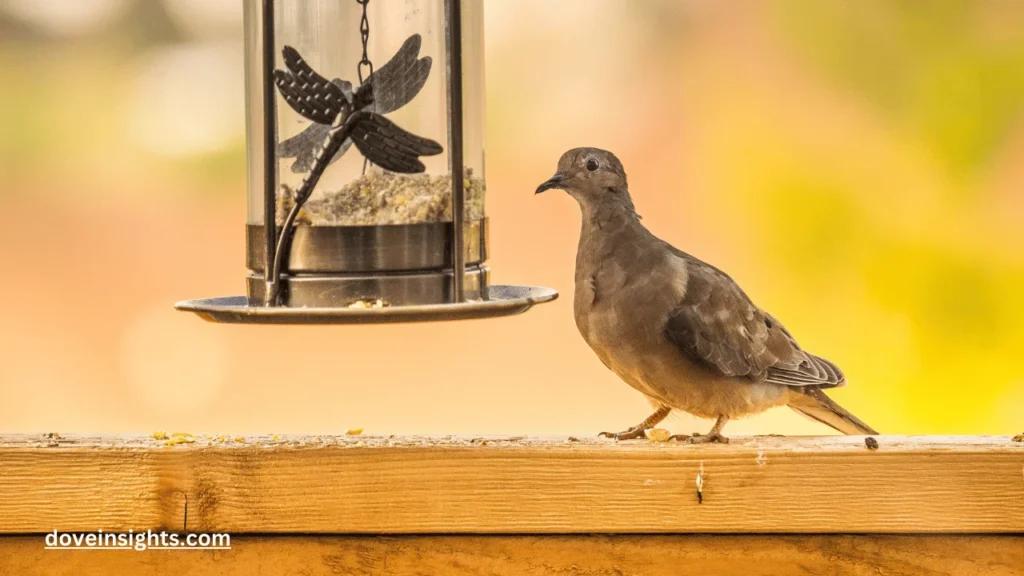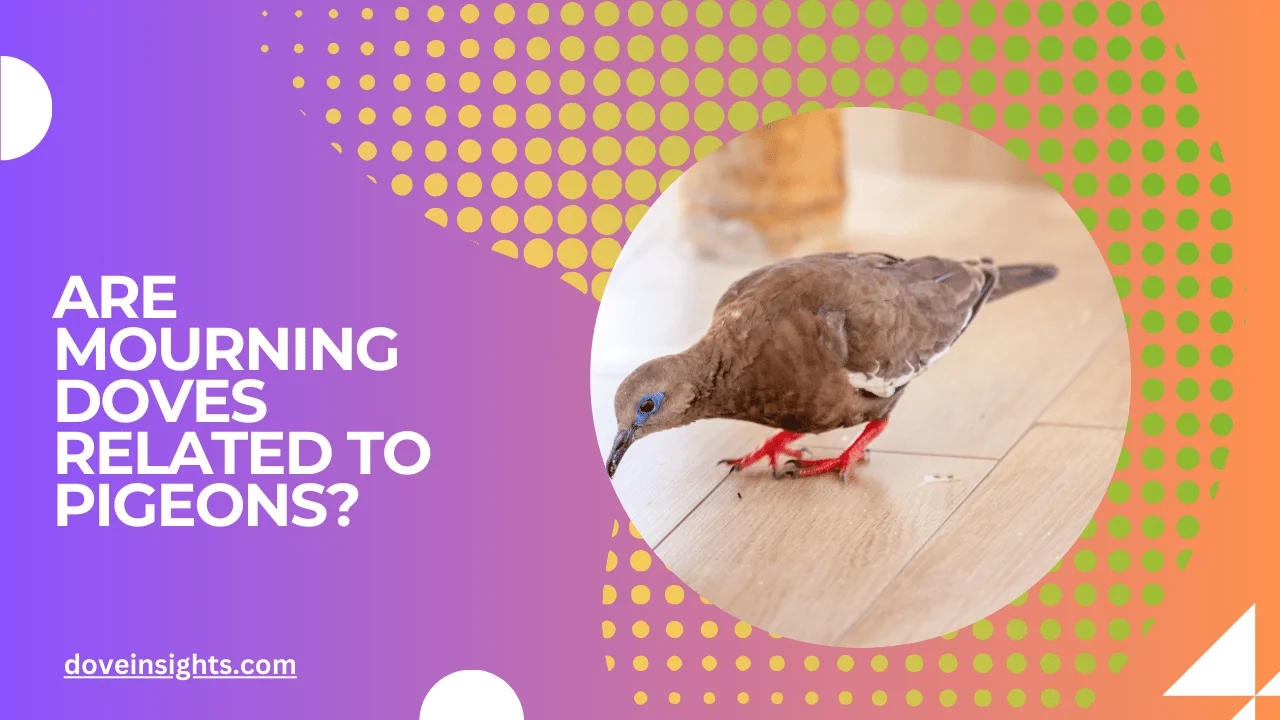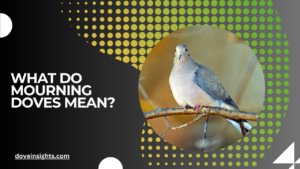When you think of mourning doves and pigeons, the first thing that often comes to mind is their similar appearance—plump bodies, small heads, and short tails.
These birds share many physical characteristics, yet they occupy different niches in the birdwatching world. Mourning doves are often associated with peaceful settings, perched in trees or cooing in gardens, while pigeons are more commonly seen in urban environments, adapting to human cities.
But are these birds truly related, or is their resemblance just a coincidence?
The question of whether mourning doves are related to pigeons isn’t just about their physical similarities; it touches on a deeper understanding of their evolutionary history, biological characteristics, and their roles in ecosystems.
Bird enthusiasts and nature lovers alike often wonder whether these birds are simply cousins in the same family, or if their differences are more significant than they first appear. Understanding this relationship is key not only to appreciating these birds but also to deepening our knowledge of the broader world of avian species.
In this article, we will explore the scientific relationship between mourning doves and pigeons, breaking down their taxonomy, evolutionary history, physical traits, and behavioral similarities.
By the end, you’ll have a clearer picture of how these two bird species are connected and why their similarities go beyond just their looks.
Contents
Understanding Mourning Doves and Pigeons: A Quick Overview
Before diving into whether mourning doves and pigeons are related, it’s important to establish what these two species are and where they fit into the bird world. Both mourning doves and pigeons belong to the Columbidae family, which is the family of doves and pigeons.
This family is quite diverse, containing over 300 species of birds found all over the world.
Mourning doves (scientific name Zenaida macroura) are typically found in North America and are characterized by their long, pointed tails, slender bodies, and soft, melodic cooing.
They are often associated with open woodlands, agricultural fields, and urban parks, thriving in a range of habitats. Mourning doves are considered non-migratory in most parts of their range but may move seasonally in search of food.
Pigeons (often referring to the rock pigeon, Columba livia), on the other hand, are more commonly found in urban environments around the globe.
Pigeons have a more robust body compared to mourning doves and are well-known for their adaptability to human-made habitats. While pigeons share many similarities with mourning doves, their behavior and habits can be quite different, often due to their extensive coexistence with humans.
Despite these differences, both birds share many evolutionary traits that link them together, including their unique anatomy and feeding habits. The next sections will explore the finer details of these connections.
Taxonomy and Evolution: Are They in the Same Family?
The scientific classification, or taxonomy, of mourning doves and pigeons reveals their close relationship. Both mourning doves and pigeons belong to the Columbidae family of birds, which includes doves, pigeons, and related species.
Within this family, mourning doves are classified under the genus Zenaida, while pigeons belong to several genera, including Columba, which is home to the common rock pigeon.
Though mourning doves and pigeons belong to the same family, they are separate genera—Zenaida for mourning doves and Columba for pigeons.
This distinction is significant in understanding the divergence of the species within the Columbidae family. The Zenaida genus includes species like the white-winged dove and Eurasian collared dove, while the genus Columba is more diverse, including rock pigeons, feral pigeons, and various other species found across the world.
While mourning doves and pigeons share a common ancestor, they diverged into different evolutionary paths. This explains both their similarities in body structure and their differences in behavior and ecology.
Despite these evolutionary splits, they retain many of the same morphological features that define them as part of the same family, such as their plump bodies, short necks, and feather structure.
Physical Similarities and Differences
Mourning doves and pigeons share some noticeable physical traits, but there are also key differences that set them apart. Here’s a look at their similarities and distinctions:
- Size and Body Shape: Both mourning doves and pigeons have a rounded body and relatively small head. Mourning doves, however, are usually slightly smaller than pigeons, with a more delicate frame. While pigeons can be quite robust, mourning doves tend to have slender bodies and longer tails.
- Coloration: Mourning doves typically exhibit soft shades of gray, brown, and beige, with a slight pinkish hue around the neck area. Pigeons, especially rock pigeons, have a more vibrant range of colors, including iridescent greens and purples around the neck, along with a variety of color patterns on their feathers.
- Tail Shape: One of the key distinguishing features between the two is the tail shape. Mourning doves have long, pointed tails that are often tipped with a white edge, whereas pigeons have shorter, squared tails.
- Beak and Head: Both species have relatively short beaks, but pigeons tend to have a slightly more robust bill compared to the delicate beak of the mourning dove. Additionally, pigeons usually have larger heads with a more pronounced forehead compared to mourning doves.
These physical differences are part of what makes each species unique, but they still share enough characteristics to be placed in the same family, Columbidae.
Behavior and Habitat: How Mourning Doves and Pigeons Live

While mourning doves and pigeons share a family tree, their behaviors and habitat preferences are somewhat different. Understanding these behavioral distinctions is essential for understanding how mourning doves and pigeons relate to each other.
- Mourning Doves: Mourning doves are often associated with open woodlands, grasslands, and suburban environments. They prefer areas with low vegetation and wide open spaces, where they can forage for seeds and take flight at a moment’s notice. Their behavior is relatively quiet, and they tend to be more solitary, often seen in pairs or small groups.
- Pigeons: Pigeons, particularly the rock pigeon, are urban dwellers, often found in cities and other man-made environments. They have adapted to living near humans, nesting on buildings, bridges, and other urban structures. Unlike mourning doves, pigeons are more gregarious, forming large flocks and often seen feeding in crowded public spaces.
Though they share some feeding habits (mainly seed-based diets), pigeons are more likely to eat from human scraps, making them more adaptable to city life. Mourning doves, by contrast, are more natural habitat-bound and often stick to their wild instincts.
Conclusion
So, are mourning doves related to pigeons? The answer is yes, but with some important nuances. Both birds belong to the Columbidae family, meaning they share a common ancestry and exhibit similar physical characteristics.
However, they have diverged into different genera, with mourning doves classified as Zenaida and pigeons as Columba, leading to variations in their behavior, habitat preferences, and ecological roles.
Mourning doves and pigeons also differ in their adaptability to urban environments. While pigeons have become synonymous with city life, mourning doves are more commonly found in natural, open spaces.
Despite these differences, the physical and behavioral similarities between the two species are a testament to their shared evolutionary lineage and their place in the broader family of doves and pigeons.
In the end, while mourning doves and pigeons may not be identical, they are inextricably linked by their evolutionary history, and understanding their relationship helps deepen our appreciation for the incredible diversity of the bird world.
FAQ’s
How long do mourning doves live?
In the wild, mourning doves have an average lifespan of 1 to 3 years, although some can live much longer in ideal conditions. Many doves face dangers such as predation, habitat loss, and disease, which can shorten their lifespan. However, in areas where they are safe and have access to food and shelter, mourning doves can live for over 10 years. Their calm nature and ability to adapt to changing environments contribute to their longevity.
Do mourning doves mate for life?
Mourning doves are monogamous during their breeding seasons, but they do not necessarily mate for life. They typically form pair bonds during the breeding season and raise a clutch of eggs together. Once the chicks fledge, the pair may separate and seek new mates for the next breeding season. Although they may stay with the same mate for an entire season, mourning doves are not lifelong partners like some other bird species.
Why do mourning doves make noise?
Mourning doves make a distinctive cooing sound primarily for communication. Their calls can serve various purposes, such as attracting mates, marking territory, and signaling alarm. The soft, melancholic coo is often heard during courtship, while the bird is perched, or during flight. The sound is part of the mourning dove’s mating behavior, as males use it to demonstrate their presence and attract females. It is also a way for doves to communicate with each other, especially in areas with large flocks.
Are mourning doves endangered?
No, mourning doves are not considered endangered. In fact, they are one of the most abundant and widely distributed bird species in North America. Mourning doves are resilient and adaptable, thriving in a wide range of habitats, including urban areas. They are protected by laws that regulate hunting, and their populations are generally stable. While they may face local threats, such as habitat destruction or predation, mourning doves are not currently at risk of extinction.
Can mourning doves be seen year-round?
Mourning doves are typically year-round residents in most areas of North America, though their migration habits depend on geographic location. In the northern regions, they may migrate southward during the colder months, seeking milder climates, while in the southern parts of the U.S., they remain present year-round. If you live in a region with a temperate climate, you are likely to see mourning doves throughout the entire year, especially in areas where food and water are plentiful.








